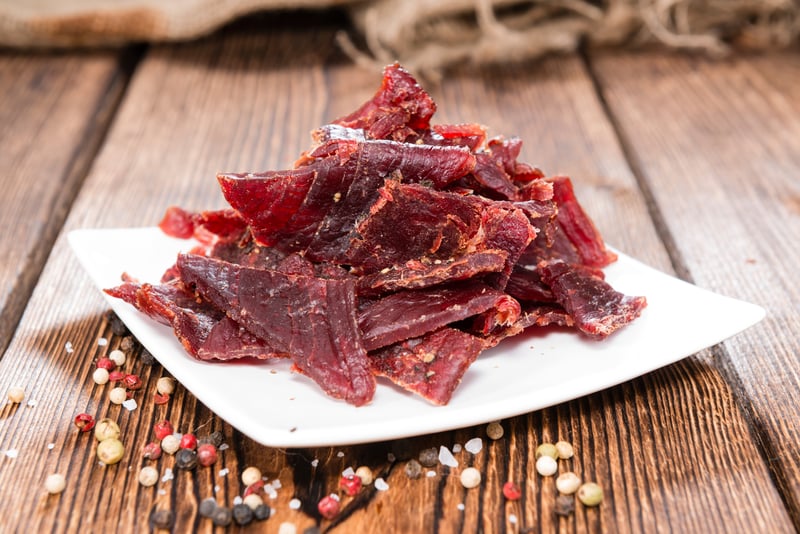Is Beef Jerky Good for You? See the Health Facts

On the go, feeling hungry, and looking for a portable, high-protein snack? Or, just craving something savory to snack on? Beef jerky checks every box and has been gaining popularity as a quick, convenient, high-protein snack. But is beef jerky healthy?
The Pros of Beef Jerky
Once upon a time, beef jerky was actually considered a junk food. Now, though, opinions have evolved, and it’s often considered a healthy snack. Beef jerky—which is typically made from lean cuts of beef, such as top round, sirloin tip, flank steak, and others—is loaded with protein. Very few high-protein foods are as convenient and portable. It’s shelf-stable, so it’s perfect for traveling, hiking, backpacking, and even keeping in the car for an emergency. It’s also (usually) low in carbohydrates, so it fits nicely into low-carb and paleo diets. In addition, jerky is good source of sodium, which is an essential nutrient that plays an important role in maintaining normal fluid balance as well as normal muscle and nerve function.
According to the USDA, one ounce of jerky provides around:
- 116 calories
- 7 grams of fat (3.1 grams of saturated fat and 3.2 grams of monounsaturated)
- 14 mg of cholesterol
- 590 mg of sodium
- 169 mg potassium
- 3.1 grams of total carbohydrates (0.5 grams of fiber and 2.6 grams of sugar)
- 9 grams of protein
However, these amounts do vary (sometimes dramatically) depending on the brand or the recipe, which is why it’s important to carefully read labels or watch recipe ingredients.
As it is made from red meat, beef jerky also provides vitamins and minerals like zinc (21% of the Daily Value or DV), vitamin B12 (12% DV), phosphorus (9% DV), folate (9% DV), iron (8% DV), copper (7% DV), choline (6% DV), selenium (5% DV), and other nutrients.
The Cons of Beef Jerky
While artisanal and gourmet jerky is simply dehydrated meat with some added salt and spices to preserve and flavor the meat, a lot of the mass-produced jerky snacks also contains highly suspect ingredients. They can be loaded with sugar or corn syrup, artificial flavors, preservatives, and sweeteners, MSG (monosodium glutamate), and soy flour.
Nitrates are often found in processed meats, such as jerky. These nutrients do occur naturally in salt and celery seed, so even the “no nitrates added” varieties will have some. And naturally-occurring nitrates, especially those provided in vegetables, have been found to provide health benefits. 1,2 Added nitrates like those found in processed meats, however, have been linked to hyperactivity, euphoria, and insomnia as well as changes in the gut microbiome and increased risk of heart disease and diabetes in some studies. 3 – 5 There is still much debate on the risk to benefit of dietary nitrates, so the nitrates in meat may or may not be a concern. 6 The verdict is still out.
Of course, beef jerky is also really high in sodium! Salt does have benefits, including being one of the body’s electrolytes, and we definitely don’t want to avoid it altogether. In truth, health risks increase with both too little as well as too much sodium. People with high blood pressure, for example, are often told to watch their salt intake and avoid consuming more than six grams of sodium per day. Just as importantly, however, is that people ensure they are consuming plenty of potassium as the full story is about the balance of electrolytes in the body.
That said, because beef jerky does provide so much sodium (22% daily allowance per the USDA), it’s a food that should be consumed in moderation rather than daily. And for people who need to consume a lower-salt diet due to health issues (such as kidney disease), it isn’t a suitable choice. 7
Beef jerky is considered a processed food. While some epidemiological studies have found that diets high in processed and cured meats, may be associated with a higher risk of certain types of cancer, no study has specifically pointed the finger at beef jerky. 8,9Nonetheless, it’s a good idea to consume an overall healthy diet that’s largely composed of nutritious, minimally processed foods.

Is Beef Jerky Good For You?
As is so often the case, the answer is, it depends. Beef jerky can be a good choice, especially if you’re on-the-go and looking for a convenient, satisfying source of protein. But it can also be a chemical bomb of questionable, if not downright unhealthy, additives. To ensure you get the highest quality beef jerky, you can make your own jerky at home in the oven, dehydrator, or air fryer, or read the label carefully to ensure you are eating a jerky made with only wholesome ingredients.
If you are purchasing beef jerky from a store, some things to look for include:
- Organic, grass-fed, hormone-free, free-range, or wild-caught meat
- Minimal processing
- Simple, straightforward ingredients such as beef, water, salt, and spices
To avoid purchasing an overly processed, junk-food version of beef jerky, avoid:
- Processed, conventional beef
- Artificial or synthetic flavors, colors, and preservatives like MSG
- Tons of sugar (over 5 grams) or corn syrup
- Refined carbohydrates like maltodextrin or barley malt
- Too much sodium (over 450 mg)
- Added fats
- Protein fillers like GMO soy flour or hydrolyzed soy protein
- While there are exceptions, it is often best to opt for jerky made with meat slices rather than “formed” meat bars or sticks, which are often a mixture of mystery “meats” and other additives
Once you’ve found a quality beef jerky, pair it with some potassium-rich vegetables or fruits (e.g., cucumbers, zucchini, oranges, bananas, cantaloupe, or watermelon) for an even more nutritious, balanced, satisfying snack on-the-go.
When it comes to beef jerky, moderation is important, and so is portion size. That bag of jerky probably isn’t a single serving. It’s more likely to contain two to three servings or more. You’ll save yourself calories, sodium, and perhaps most of all, cash by sharing it with a friend or taking out a single portion and saving the rest for later. (Remember to refrigerate it after opening, and you probably want to keep any homemade jerky in the fridge as well to help prevent bacterial growth.) As with any dried food (e.g., dried fruit), once the water has been removed, the portion size shrinks dramatically as well, so a serving of steak versus a serving of jerky is quite different. Just keep that in mind as you snack and enjoy a serving that’s around the size of a credit card (around one ounce) rather than a palm.
If you are cutting back on red meat (it’s often recommended we eat no more than four servings of red meat per week), you can find other jerky options, including chicken, turkey, salmon, pork, and even vegan options. Regardless of the source, the same guidelines mentioned above still apply.
Lastly, make sure you have your water bottle handy when you nosh on your beef jerky. You’ll likely need the extra water to stay properly hydrated (because jerky is a relatively concentrated source of sodium).
If beef jerky fits into your dietary pattern, you choose wisely, and consume it moderately, it can be an excellent source of on-the-go protein and fit into your healthy diet. If, on the other hand, you just grab something that’s close to the convenience store counter, you likely are getting 100% junk food.







